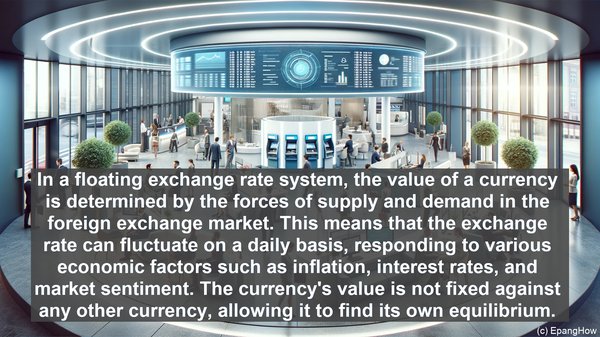Introduction: The Role of Exchange Rates in Global Economies
Hello everyone! Today, we delve into the world of exchange rates, which serve as the backbone of international trade and economic stability. In particular, we will explore the contrasting dynamics of floating and fixed exchange rate systems.
Floating Exchange Rates: The Market’s Invisible Hand
In a floating exchange rate system, the value of a currency is determined by the forces of supply and demand in the foreign exchange market. This means that the exchange rate can fluctuate on a daily basis, responding to various economic factors such as inflation, interest rates, and market sentiment. The currency’s value is not fixed against any other currency, allowing it to find its own equilibrium.
Advantages of Floating Exchange Rates
One of the key advantages of a floating exchange rate is its ability to self-adjust. For instance, if a country’s exports become more competitive due to a depreciating currency, it can boost its economy by attracting more foreign buyers. Additionally, floating rates act as a shock absorber, helping to mitigate the impact of economic crises. As the exchange rate adjusts, it can aid in restoring balance and competitiveness.
Challenges of Floating Exchange Rates
While flexibility is a strength, it can also be a source of volatility. Sharp currency fluctuations can create uncertainty for businesses engaged in international trade, making it harder to plan and forecast. Moreover, in certain cases, a rapidly depreciating currency can lead to imported inflation, as the cost of imported goods rises. This can have implications for a country’s overall price stability.
Fixed Exchange Rates: Stability at a Price
In contrast, a fixed exchange rate system involves pegging a currency’s value to another currency or a basket of currencies. This peg is typically maintained by a central bank, which intervenes in the foreign exchange market to buy or sell its currency as needed. The goal is to keep the exchange rate stable and predictable.
Benefits of Fixed Exchange Rates
The primary advantage of a fixed exchange rate is stability. By having a fixed value, businesses can engage in international trade with a greater degree of certainty. This can promote long-term investments and economic growth. Additionally, fixed rates can help control inflation, as the central bank can adjust its monetary policy to maintain the desired exchange rate.

Drawbacks of Fixed Exchange Rates
However, maintaining a fixed exchange rate requires significant resources and intervention from the central bank. In some cases, this can deplete foreign exchange reserves. Moreover, if the fixed rate is not in line with the market’s perception of the currency’s value, it can create imbalances, leading to speculative attacks and potential currency crises.

